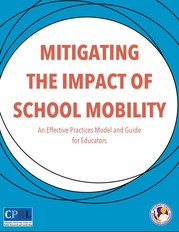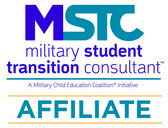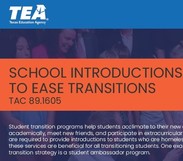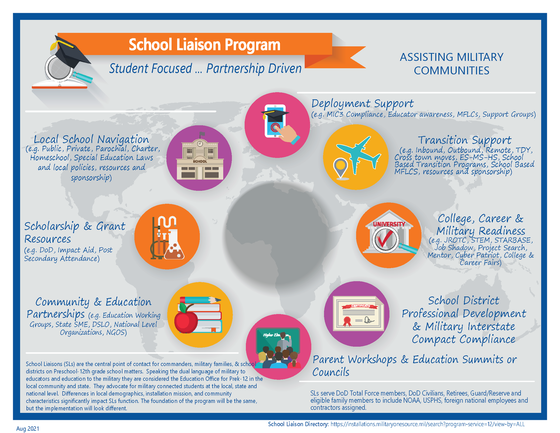|
Has your school considered applying to become a Purple Star Campus? The most important part of being a Purple Star Campus is providing students and families with transition supports that welcome them into the school environment and ease the burden of school moves, while also providing intentional recognition and supports for addressing the unique needs of military-connected students and families.
There are model programs, services, and best practice strategies that may be implemented to assist schools in meeting the Purple Star Designation criteria. Below are resources for consideration. Many of the resources are free, while others require funding for implementation. Schools have the flexibility to develop individualized programs that fit their unique needs.
**The following resources are for consideration only and are not required for the school to be designated as a Purple Star Campus.
Campus-Based Military Liaisons
 |
|
The Military Child Education Coalition (MCEC) collaborated with Columbia University to create a model for student transitions, along with a toolkit of strategies, templates, and checklists to help teachers, principals, counselors, and district personnel more effectively serve transitioning mobile students. This resource is available for free. Military liaisons and school staff can use this document to develop services for military-connected students.
|

A Military Student Transition Consultant Affiliate (MSTA) program enables districts with military-connected student populations to join a powerful network of nationwide resources to support smooth transitions and respond to student and family concerns.
The MSTA is an employee of the LEA assigned to a campus. In addition to this Guidance Professional's responsibilities, participation as an Affiliate provides additional resources and support through the MCEC network to assist military-connected students.
|
Student Transition Programs
 |
|
This one-pager will describe different types of programs your school can implement to introduce students to the campus. A student ambassador program is highly recommended to help new students make connections and acclimate to the new school environment. This resource will be posted to the HM&AR webpage soon!
|
 |
|
Student 2 Student® (S2S™) is a high school level student program that brings military and civilian students together to welcome new students, create a positive environment, support academic excellence, and ease transitions. Schools can request training to implement S2S programs and consider options for funding via the MCEC website.
|
Military Initiatives
Connect with a School Liaison (SL) to build a partnership with your nearby military installation and engage your school community with the military community. You can work with your SL to encourage and provide opportunities for active duty military members to volunteer in the local schools, speak at a school assembly, or host a school field trip. See the section below for more information on SLs.
School Liaison Program
 Schools and districts that are impacted by a military installation have access to the local School Liaison (SL), an individual employed by the installation who builds partnerships between schools and the military. School and district staff are encouraged to work with their SLs to build quality services and drive positive change in their schools. Reach out to your local SL for the following activities:
- Military family transition and deployment support
- Professional development for school staff
- Sponsorship programs for your schools
- Scholarships and grant opportunities
- Military Interstate Compact compliance support
- Purple Star Campus activities
- Establishing partnerships with military installations to collaborate and host events, coordinate field trips, and facilitate opportunities for soldiers to volunteer/mentor on campus.
 |
|
Updates from the 87th Texas Legislature
|
House Bill 3932 authorized the creation of the State Advisory Council on Educational Opportunity for Military Children, which will increase coordination among state agencies, school districts, and military installations concerning the state’s participation in and compliance with the Interstate Compact on Educational Opportunity for Military Children.
Eleven or more members will be added to the council to oversee the Interstate Compact and participate in the Military Interstate Children's Compact Commission (MIC3). The council may develop policy concerning operations and procedures of the Interstate Compact within the state. Further, the council will help increase knowledge of the Interstate Compact requirements for LEAs, thereby increasing educational supports for military-connected students.
House Bill 4124 allows school districts operated by Texas universities to prioritize military-connected students for enrollment or on waitlists for enrollment. These school districts may also enroll and receive funding for a student who does not technically reside in the state (due to a military deployment or transfer) if the student is a dependent of a member of the US military and has previously been enrolled in school in Texas.
LEAs should note that “dependent of a member of the US military” is not synonymous with “military-connected student,” a term that encompasses dependents of veterans and members killed in the line of duty (TEC § 25.006(d)).
PCSing at the start of the school year?
A permanent change of station (PCS) is an assignment that requires service members to move between one duty station to another. These assignments typically last between 2-4 years. While a PCS can occur at any time, the peak moving season for military families occurs between May 15th through August 31st.
Upcoming Newsletters
Each program in the Highly Mobile and At-Risk division releases newsletters every two months. Subscribe to all of the HM&AR newsletters to receive more in-depth updates on these student programs:
- Highly Mobile and At-Risk Student Programs
- Military-Connected Students
- Texas Education for Homeless Children and Youth
- Foster Care and Student Success
- Mental and Behavioral Health
|